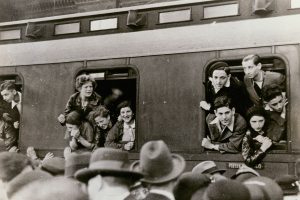
Collection of 40,000 Deposit Cards from the World War II Era Features Albert Einstein Record
JDC Transmigration Bureau card shows aid extended by Einstein during World War II.
The card (pictured below) illustrates that Albert Einstein deposited funds with JDC towards the travel costs of Hugo Moos, a friend or a relative living in his hometown of Ulm, Germany. Included are Einstein’s name and address in Princeton, NJ.
Transmigrant card illustrating that Albert Einstein deposited funds with JDC toward the travel costs of Hugo Moos
JDC established its Transmigration Bureau in 1940 in New York to help refugees emigrate from Germany, Austria, Czechoslovakia, Holland, Belgium, and Luxembourg, primarily to the U.S. Its primary role was to accept deposits from friends or family overseas towards the travel costs of Jews emigrating from Europe. The JDC Archives has indexed deposit cards for 37,732 individuals who emigrated from 1940-1956, with the bulk from 1940-1942.
Research of ship manifests has turned up a Manifest of Alien Passengers for the S.S. Scythia which sailed from Liverpool on February 22, 1940 with a child passenger named Rudolf Hugo Moos on board. Rudolf Hugo Moos was born in Berlin and his last residence at the time was in Belgium. Could this be the same Hugo Moos who was helped by Albert Einstein?
In 1936, Einstein and his wife Elsa purchased a home at 112 Mercer Street in Princeton, where he lived until his death in 1955. In 1976, the house was added to the National Register of Historic Places. According to biographer Ronald Clark, Einstein’s house on Mercer Street was a very conducive environment for him to work. As Clark stated in his definitive work about the famed physicist, “Thus he was always anxious to get back…to the intellectual workshop of Princeton. He could of course work anywhere…Nevertheless his room in the institute or his study in Mercer Street was his natural environment. It was here that he could best carry out his main work and continue his stubborn rearguard battle against the new movements in physics which he had started nearly a third of a century before.”



